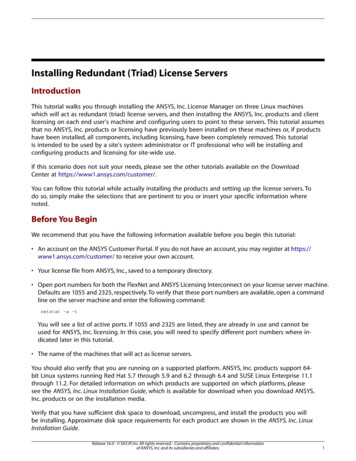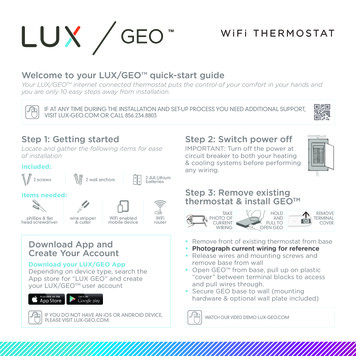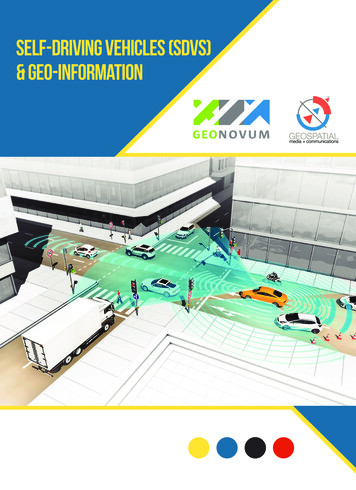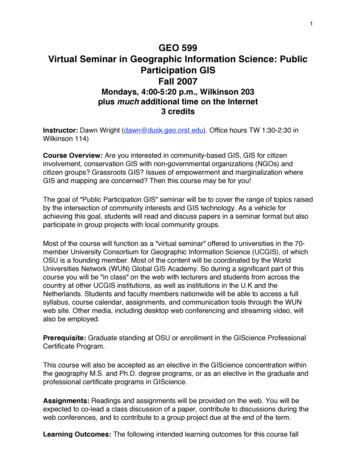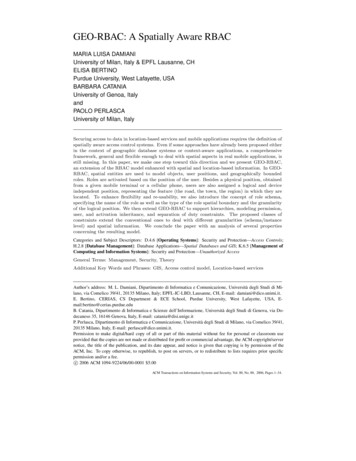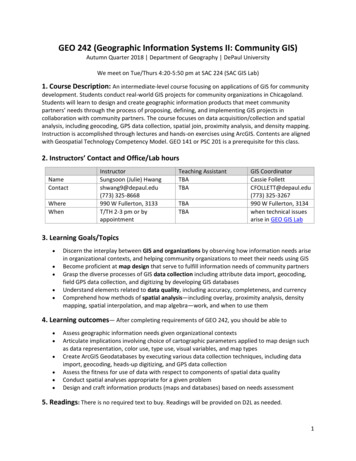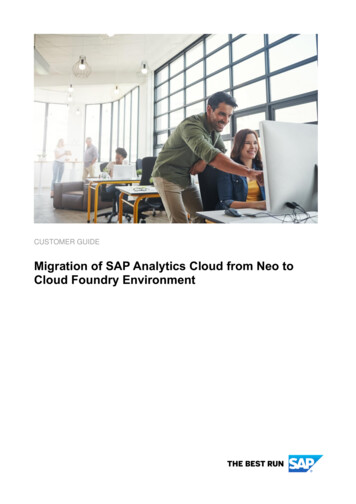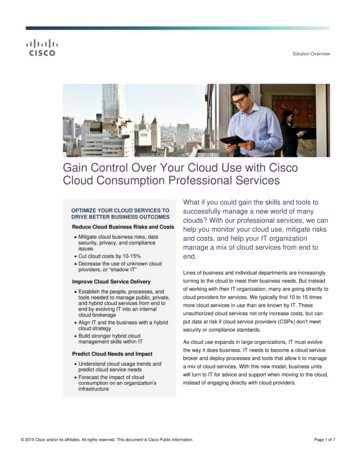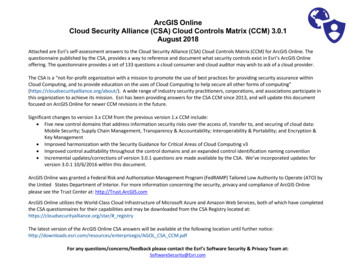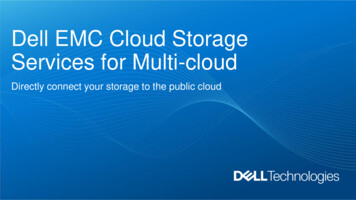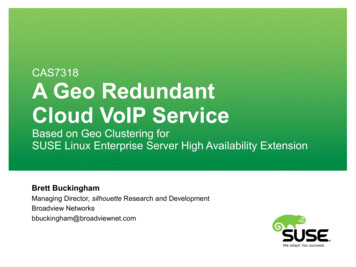
Transcription
CAS7318A Geo RedundantCloud VoIP ServiceBased on Geo Clustering forSUSE Linux Enterprise Server High Availability ExtensionBrett BuckinghamManaging Director, silhouette Research and DevelopmentBroadview Networksbbuckingham@broadviewnet.com
AbstractBroadview Networks' "OfficeSuite Phone" is a cloudbased VoIP service used by over 120,000 businesssubscribers daily. The primary product underlyingOfficeSuite Phone, silhouette, is a carrier-gradetelecom product. We have recently extendedsilhouette's existing high availability architecture tosupport geographic redundancy. This presentation is acase study of the use of Geo Clustering for SUSE LinuxEnterprise High Availability Extension. We will outlinethe challenges and solutions to several aspects of georedundancy, including database replication, filesystemreplication, geo cluster overlay, and the design of adead man's switch to control geo failover.2
Table of Contents3 Product overview Rationale for geo redundancy Geo redundancy overview Geo cluster architecture Database replication Filesystem replication Dead man's switch Lessons learned
Product Overview
Product Overview5 silhouette is sold to cloud services providers (CSPs) CSPs use silhouette to provide phone service tosmall to medium businesses 1 silhouette supports 20,000 subscribers (e.g.equivalent of 1000 PBXs with 20 subscribers each) Cloud VoIP: only phones and IP network at customersite Businesses manage their phone service entirely via aweb interface Broadview Networks hosts the OfficeSuite servicebased on silhouette (Broadview is a CSP), and alsolicenses silhouette to other CSPs
Phone System Managed via Web6
silhouette is Widely Deployed7 Broadview Networks has 14 silhouette systems inproduction underpinning the OfficeSuite Phoneservice, serving over 120,000 business users everyday Broadview licenses silhouette to 17 other CSPs worldwide, which combined serve an additional 60,000business users every day
silhouette is Carrier-GradeAs a product intended to be hosted by cloud andtelecom service providers, silhouette is subject tocarrier-grade requirements, such as:8 Availability: 99.999% Reliability: 99.99% Scalability and throughput Real-time responsiveness Manageability and serviceability Security
Other Product Information Developed over past 13 years; in live productionservice for 10 years Software onlyComprised of several (25 ) software componentsDeployed on carrier-class X64 serversSLES HAE Geo is embedded in the productInterfaces with network peer components for some functions Deployed on 3 servers over 2 tiers:Web-tier: single node HA “cluster”Call-tier: 2 node HA cluster9
Network DiagramInternetweb tierVoIP ALG0call tier1ManagedNetworkvoicemailmedia svrPSTNgwyPSTN10
Rationale for Geo Redundancy
Why Geo Redundancy?12 Customers expect it / require it Business continuity safeguard
Expectations of a Cloud Service13 Using a cloud service means trusting a CSP to provideand manage the service. There can be an emotionalbarrier to trust a 3rd party vs. control the service inhouse If the service is business critical (e.g. phone, email),the emotional barrier can be amplified Cloud services are presumed to be relocatable,distributed, resilient, not tied down to hardware orlocation; this can help to offset the angst Geo redundancy is at least an implicit expectation,and often is an explicit RFP check box, especially bycustomers who have recently experienced a disaster
Business Continuity / Disaster Recovery14 Business continuity refers to plans, policy, preparation,and procedure to safeguard a business and continueits operations despite serious incidents or disasters Some disasters are related to geography, e.g. floodzones, earthquake fault lines, common public utilities,etc. A geo redundant system intends to safeguard thesystem against geographic disasters, thereforeredundant systems should be geographically diverse
Our Experience with Hurricane Sandy Destructive and deadly Atlantic hurricane in October2012 which affected Caribbean and east cost of NorthAmerica Well prepared (100% uptime), but learned a lot In one of Broadview's telecom central offices in NYC:Commercial power down for 2 weeks, then unreliable for 2additional months. We were on generator power throughout.Basement and lobby flooded, travel in/out of Manhattanimpossible. Operations personnel on-site continuously for severaldaysSome circuits from peering partners were down, and ultimatelysome partner COs were unrecoverable due to salt water damage15
Geo Redundancy Overview
System and Network IPALG
Replication to Backup ilhouetteVoIPALG
Primary System Failure lsilhouetteVoIPALG
Backup System lsilhouetteVoIPALG
Network Peers Connect toNew silhouetteVoIPALG
Recovered System BecomesNew ilhouetteVoIPALG
Basic Concepts23 Continuously replicate silhouette configuration andoperational data to a backup geo site Only the primary geo site (typically) provides serviceat any one time Detect failure of primary site, promote backup toprimary Implement mechanisms for network peers and phones(i.e. client systems) to recognize and toleratesilhouette changing location (IP)
Geo Cluster Architecture
Geo Cluster25 Employs Geo Clustering for SUSE Linux EnterpriseHigh Availability Extension Silhouette primary and backup geo sites are linked ina geo cluster to an arbitrator node in a 3rd geo site Only call tier nodes participate in the geo cluster; webtier nodes are subordinate to and controlled by the calltier Typically only one silhouette provides service at anyone time, as directed by a ticket scheme in the geocluster
Geo ClusterGeo Site CArbitratorHA framework Geo26Geo Site AGeo Site BHA framework GeoHA framework GeoServer Server01Server Server01
Database Replication
High Availability Databases silhouette contains 2 databases:Main database: provisioned system and business dataBilling database: call records28 Both databases are implemented with PostgreSQL Each database has HA requirements, and employsPostgreSQL streaming replication to a warm standbyslave within local cluster Stock PostgreSQL resource agent (RA) wasinadequate for this master/slave arrangement We developed a custom design and RA
Warm Standby Slave with StreamingReplicationClient AClient BClient NMaster IPMaster29Streaming replicationSlave
Master FailsClient AClient BClient NMaster IPMaster30Slave
Slave is Promoted, IP Follows,Clients ReconnectClient AClient BClient NMaster IPMasterCould be out of dateNo longer valid31
Failed Instance Restarts as SlaveClient AClient BClient NMaster IPMasterOn-disk files erased32
Failed Instance Restarts as SlaveClient AClient BClient NMaster IPMasterkbaclluf33up
Failed Instance Restarts as SlaveClient AClient BClient NMaster IPSlave34Streaming replicationMaster
Initial Startup In Pacemaker the startup sequence for a master /slave resource is as follows:Pacemaker starts resource as a slave on node APacemaker starts resource as a slave on node BPacemaker chooses one instance to promote to master35
Master / Slave Resource State 6stop
Initial Startup Problem Problem: for our design, “starting as a slave” means toprepare a slave database as follows:1.Erase files on disk (both instances would do this, and wipe outall data!)2.Obtain a full backup from master instance (this would fail there isn't one yet)3.Start slave database instance in PostgreSQL “hot standbyrecovery-mode” with streaming replication37
Initial Startup Problem: Solution Custom PostgreSQL resource agent When told to start as a slave:If there is a running master, prepare and start slave as normalIf there is no running master:Do nothingReturn OCF SUCCESS to Pacemaker as if successfully started as a slaveWhen Pacemaker eventually promotes one instance:Start that instance as a master from disk imagePrepare and start the other instance as a slave38
Modified Master / SlaveResource State Machinemanagestoppedstartslave.awaiting rolemaster up// aster39promoteIn these states monitor operationsreturn OCF SUCCESS.Pacemaker is led to believe thedatabase is running as a slave. It isonly actually doing so inslave.replicating state.
Additional Enhancements40 “Fallback” images: rotation of regular databasebackups are taken on each node and stored locally. Ifnormal HA mechanisms fail, or the database iscorrupted, the RA will start the database from afallback image Enhanced monitoring: for our purposes, it is notsufficient to deem a database to be alive based onthere being a running PID. Our RA performsrepresentative database queries.
Geo Redundancy Extensions41 Database replication from primary geo site to backupgeo site is the same PostgreSQL streaming replication Additional modifications to the state machine in the RAaccommodate “local slaves” and “geo slaves” Significant additional complication when workingacross geo sites, as HA events (notifies, etc.) do nottraverse the geo cluster The design pattern we used extensively is to performvarious event transition checks during regular monitoroperations
Geo Redundant Master / SlaveResource State Machinemanagestoppedstartslave.awaiting roledemotelocal master up// prepareslave.local preparingdoneslave.geo preparingpromoteslave.local replicatingdoneslave.geo replicatingmaster42geo master up// preparedemote
Filesystem Replication
Filesystem Replication44 Some silhouette components are made highlyavailable by storing their state on a filesystem sharedbetween the nodes of the local cluster (e.g. DHCPserver's conf and lease files) Select portions of this shared filesystem needed to bereplicated to the backup geo site We explored various options, such as clusterfilesystems (GFS, OCFS), DRBD layers, csync2, etc. For our application and constraints, thesetechnologies were not appropriate We implemented a simple pull paradigm replicatorcomponent based on rsync
Dead Man's Switch
Dead Man's Switch46 silhouette's geo redundancy architecture includes adead man's switch implemented by a customcomponent called the geo-manager the dead man's switch decouples geo clusterdecisions from geo site service decisions basic idea: if the geo cluster decides that a geofailover should happen, a dead man's switch timer(default: 2 hours) is started the geo failover can be manually confirmed or abortedbefore the timer expires if the timer expires, geo failover happens automatically allows geo failover intervention by operations persons
Geo Role vs Geo Service Role47 Geo role: the role that the geo cluster wants a geo siteto be. If geo-ticket is granted, the geo role is “provideservice”. If revoked, the geo role is “replicate” Geo service role: the actual service role (“provideservice” or “replicate”) that a geo site takes on at agiven moment. The geo role as embodied by the geo-ticket is asuggestion to the geo-manager. The geo-managercontrols the actual geo service role by a local clusterticket called geo-service-ticket
Geo Role State MachineGeo rovide service48
Geo Service Role State MachineGeo Service Roleset geo service role to replicate// revoke icket granted// start DM timerDM timer expired// revoke geo-service-ticketpending transitionto provide servicepending transitionto replicateunset geo service rolegeo-ticket revoked// start DM timerDM timer expired// grant geo-service-ticketprovide servicefixedprovide serviceset geo service role to provide service// grant geo-service-ticket49
Lessons Learned
Lessons Learned51 Geo Clustering for SUSE Linux Enterprise HighAvailability Extension 11 SP3 was not robust enoughfor production deployment. We had to use the GeoClustering extension from SUSE Linux Enterprise 12. We were forced to implement basic infrastructure suchas filesystem replication Pacemaker and the geo cluster overlay did not alwaysprovide sufficient events for us to implementsophisticated resource agents. Our RAS rely heavilyon regular monitor operations as an entry point to pollfor events
52
Unpublished Work of SUSE LLC. All Rights Reserved.This work is an unpublished work and contains confidential, proprietary and trade secret information of SUSE LLC.Access to this work is restricted to SUSE employees who have a need to know to perform tasks within the scope oftheir assignments. No part of this work may be practiced, performed, copied, distributed, revised, modified, translated,abridged, condensed, expanded, collected, or adapted without the prior written consent of SUSE.Any use or exploitation of this work without authorization could subject the perpetrator to criminal and civil liability.General DisclaimerThis document is not to be construed as a promise by any participating company to develop, deliver, or market aproduct. It is not a commitment to deliver any material, code, or functionality, and should not be relied upon in makingpurchasing decisions. SUSE makes no representations or warranties with respect to the contents of this document,and specifically disclaims any express or implied warranties of merchantability or fitness for any particular purpose. Thedevelopment, release, and timing of features or functionality described for SUSE products remains at the solediscretion of SUSE. Further, SUSE reserves the right to revise this document and to make changes to its content, atany time, without obligation to notify any person or entity of such revisions or changes. All SUSE marks referenced inthis presentation are trademarks or registered trademarks of Novell, Inc. in the United States and other countries. Allthird-party trademarks are the property of their respective owners.
Broadview Networks' "OfficeSuite Phone" is a cloud-based VoIP service used by over 120,000 business subscribers daily. The primary product underlying OfficeSuite Phone, silhouette, is a carrier-grade telecom product. We have recently extended silhouette's existing high availability architecture to support geographic redundancy. This .
